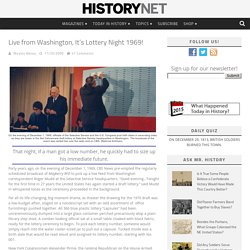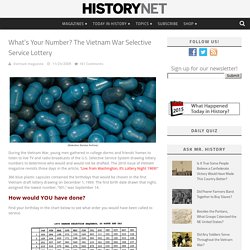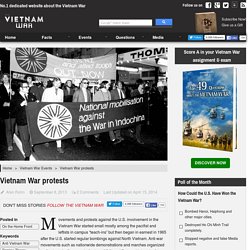

Anti-Vietnam War Protest Movement by Millie Costley on Prezi. Live from Washington, It’s Lottery Night 1969! On the evening of December 1, 1969, officials of the Selective Service and the U.S.

Congress post birth dates in ascending order, as they are drawn in the first Vietnam-era draft lottery at Selective Service headquarters in Washington. The broadcast of the event was carried live over the radio and on CBS. (National Archives) That night, if a man got a low number, he quickly had to size up his immediate future. Forty years ago, on the evening of December 1, 1969, CBS News pre-empted the regularly scheduled broadcast of Mayberry RFD to pick up a live feed from Washington correspondent Roger Mudd at the Selective Service headquarters. For all its life-changing, big-moment drama, as theater the drawing for the 1970 draft was a low-budget affair, staged on a nondescript set with an odd assortment of office furnishings pushed together. Tom, No. 030: “Since 1969 I have been telling friends that the only lottery that I have ever won was the 1969 draft lottery. Gen. What’s Your Number? The Vietnam War Selective Service Lottery. (Selective Service Archive) During the Vietnam War, young men gathered in college dorms and friends’ homes to listen to live TV and radio broadcasts of the U.S.

Selective Service System drawing lottery numbers to determine who would and would not be drafted. The 2010 issue of Vietnam magazine revisits those days in the article, “Live from Washington, It’s Lottery Night 1969!!” 366 blue plastic capsules contained the birthdays that would be chosen in the first Vietnam draft lottery drawing on December 1, 1969. The first birth date drawn that night, assigned the lowest number, “001,” was September 14. How would YOU have done? Find your birthday in the chart below to see what order you would have been called to service. How did Prominent Figures do? Oliver Stone: 113, September 14, 1946 Pat Sajak: 007, October 26, 1946 Bruce Springsteen: 119, September 23, 1949 Sylvester Stallone: 327, July 6, 1946 Samuel Alito: 032, April 1, 1950. Protests against the Vietnam War.
Protests against the Vietnam War did not start when America declared her open involvement in the war in 1964.

America rallied to the call of the commander-in-chief and after the Gulf of Tonkin incident it became very apparent that few would raise protests against the decision to militarily support South Vietnam. America had been through nearly twenty years of the Cold War and they were told by the government that what was happening in South Vietnam would happen elsewhere (the Domino Theory) unless America used her military might to stop it. Involvement in the Vietnam War was very much sold as a patriotic venture so few were prepared to protest. If there was to be a political protest, it never became apparent in Congress where the entire House voted to support Johnson and only two Senators voted against US involvement.
The first protests came in October 1965 when the draft was increased. “Hey! Vietnam War protests - The Vietnam War. Movements and protests against the U.S. involvement in the Vietnam War started small mostly among the pacifist and leftists in campus “teach-ins” but then began in earnest in 1965 after the U.S. started regular bombings against North Vietnam.

Anti-war movements such as nationwide demonstrations and marches organized by Students for Democratic Society (SDS) and Furman University Corps of Kazoos (FUCK) attracted huge public support and worldwide attention over the next 3 years, peaking in early 1968 after the Tet Offensive which proved the end of the war was nowhere in sight and remaining influential until the end of the conflict in 1973. The Beginning When the U.S. began its military involvement in Vietnam in 1964, not many Americans opposed it. Began in Earnest The conscription for the war also increased the level of demonstration, particularly among young men.
High Casualties The protests against the war started to shoot up when body bags returning to American kept increasing. Page 1 of 2.